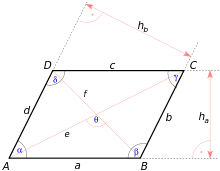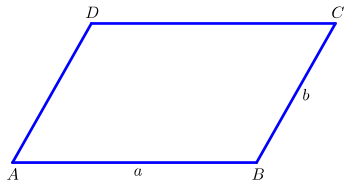parallelogram
A parallelogram (from ancient Greek παραλληλό-γραμμος paralleló-grammos "bounded by two pairs of parallels") or rhomboid (diamond-like) is a convex, flat square with opposite sides parallel .
Parallelograms are special trapezoids and two-dimensional parallelepipeds . Rectangle , diamond (rhombus) and square are special cases of the parallelogram.
properties
A square is a parallelogram if and only if one of the following conditions is met:
- Opposite sides are of the same length and no two opposite sides intersect (no overturned square, so-called antiparallelogram ).
- Two sides are parallel and of equal length.
- Opposite angles are the same size.
- Any two adjacent angles add up to 180 °.
- The diagonals bisect each other.
- The sum of the areas of the squares over the four sides is equal to the sum of the areas of the squares over the two diagonals ( parallelogram equation ).
- It is point symmetric (twofold rotationally symmetric ).
The following applies to every parallelogram:
- Each diagonal divides it into two triangles that are congruent in the same direction .
- Its center of symmetry is the intersection of the diagonals .
- The centers of the squares erected over its sides form a square ( theorem of Thébault-Yaglom ).
All parallelograms that have at least one axis of symmetry are rectangles or diamonds .
Formulas
| Mathematical formulas for the parallelogram | ||
|---|---|---|
| Area |
|

|
| scope | ||
| Interior angle | ||
| height | ||
| Length of the diagonal
(see cosine law ) |
||
| Interior angle | ||
| Parallelogram equation | ||
Proof of the area formula for a parallelogram

The area of the adjacent black parallelogram can be obtained by subtracting the six small areas with colored edges from the area of the large rectangle . Because of the symmetry and the interchangeability of the multiplication , you can also subtract twice the three small areas below the parallelogram from the large rectangle. So it is:
Construction of a parallelogram
A parallelogram, wherein the side lengths and as well as the height is given, is provided with ruler and compass constructible .

Generalizations
A generalization to dimensions is the parallelotope , explained as the set and its parallel displacements . They are linearly independent vectors . Parallelotopes are point symmetrical .
The three-dimensional parallelotope is the parallelepiped . Its side surfaces are six parallelograms that are congruent in pairs and lie in parallel planes . A parallelepiped has twelve edges, four of which are parallel and of equal length, and eight corners in which these edges converge at a maximum of three different angles .
Use in technology
Parallelograms are often found in mechanics. A movable, true-to-parallel mounting, the so-called parallelogram guide, can be created by four joints . Examples:
Switching parallelogram of a derailleur system
Parallel wipers
literature
- F. Wolff: Textbook of Geometry. Fourth improved edition, printed and published by G. Reimer, Berlin 1845 ( online copy ).
- P. Kall: Linear Algebra for Economists. Springer Fachmedien, Wiesbaden 1984, ISBN 978-3-519-02356-2 .
- Wilhelm Killing: Textbook of Analytical Geometry. Part 2, Outlook Verlagsgesellschaft, Bremen 2011, ISBN 978-3-86403-540-1 .
Web links
- Eric W. Weisstein : Parallelogram . In: MathWorld (English).
- Area and circumference calculation of general and special parallelograms. ( Memento from January 11, 2015 in the Internet Archive ). Retrieved November 18, 2016.
- Introduction to the subject of the parallelogram. (PDF; 920 kB). Retrieved November 18, 2016.
- Parallelogram and diamond. ( Memento from November 19, 2016 in the Internet Archive ; PDF; 225 kB). Retrieved November 18, 2016.


























